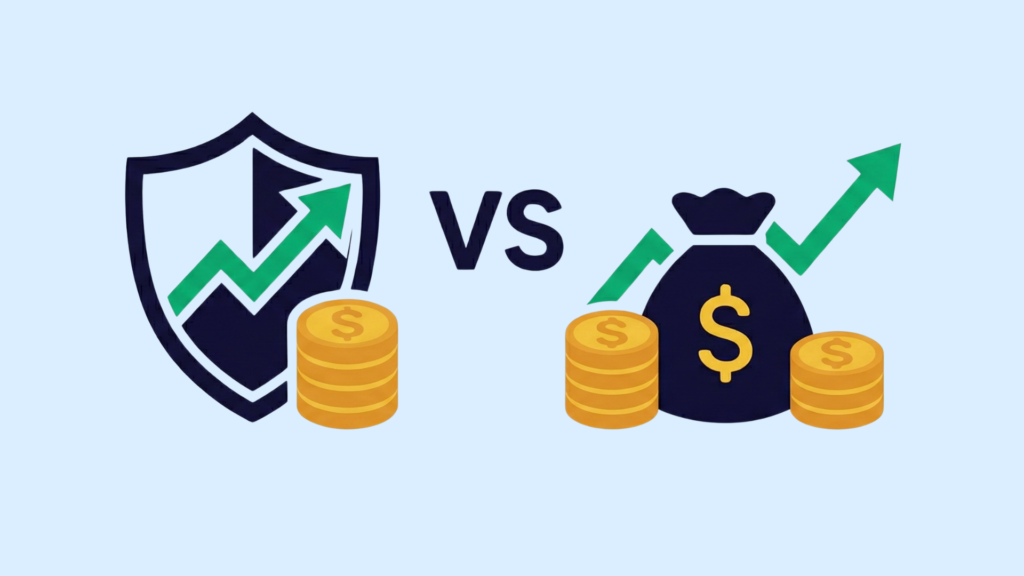The Sharpe Ratio helps investors see if a mutual fund’s returns are truly worth the risk, separating smart performance from mere market luck. It’s one of the simplest yet most valuable tools for understanding risk-adjusted returns.
In this blog, we’ll break down what the Sharpe Ratio means, how it’s calculated, how to interpret it, and how you can use it to compare mutual funds and create a stronger investment portfolio.
Introduction to the Sharpe Ratio
The Sharpe Ratio compares a fund’s excess return—returns above the risk-free rate—to its volatility or risk. In simple terms, it tells you how much return a fund generates for each unit of risk.
Why Is the Sharpe Ratio Important for Mutual Funds?
The Sharpe Ratio in mutual funds is crucial because it allows for fair comparisons between different funds, regardless of their category or investment style.
- Measures Risk-Adjusted Performance: It shows not just how much a fund earns, but how efficiently it earns those returns given the risk taken.
- Helps Compare Similar Funds: Two funds may have similar returns, but the one with a higher Sharpe Ratio is managing risk better, which makes it more attractive to long-term investors.
- Guides Smarter Investment Choices: By looking at the Sharpe Ratio, investors can identify funds that strike a good balance between risk and reward.
How Is the Sharpe Ratio of a Mutual Fund Calculated?
The standard formula for calculating the Sharpe Ratio is:
Sharpe Ratio = (Average Return of the Fund – Risk-Free Rate) ÷ Standard Deviation of the Fund’s Returns
Where:
- Average Return of the Fund = The fund’s average annual return.
- Risk-Free Rate = The return from a risk-free investment, such as government bonds.
- Standard Deviation = A measure of how much the fund’s returns fluctuate (volatility).
Example of Sharpe Ratio Calculation for a Mutual Fund
Let’s assume the following for a mutual fund:
- Average Annual Return of the Fund = 12%
- Risk-Free Rate = 4%
- Standard Deviation (Volatility) = 8%
When you apply the formula:
Sharpe Ratio = (12% – 4%) ÷ 8%
Sharpe Ratio = 8% ÷ 8% = 1.0
Interpretation:
- A Sharpe Ratio of 1.0 means the fund is earning one unit of return for every unit of risk taken—a solid, well-balanced performance.
- Ratios above 1.0 indicate excellent risk-adjusted returns.
- Ratios below 0.5 suggest the fund may not be compensating enough for the risks involved.
Understanding the Sharpe Ratio in Mutual Funds
The Sharpe Ratio in mutual funds is a major indicator of how efficiently a fund delivers returns relative to the risk it takes. It goes beyond raw performance numbers to show whether a fund’s returns are worth the volatility involved.
Interpreting the Sharpe Ratio of a Mutual Fund
When evaluating a mutual fund, the Sharpe Ratio tells you how well it has performed after adjusting for risk. The higher the ratio, the better the fund’s risk-adjusted returns. Here’s how to interpret it:
| Sharpe Ratio Value | Interpretation |
| Above 1.0 | Excellent; the fund is delivering strong returns for the level of risk taken. |
| Between 0.5 and 1.0 | Average returns are acceptable but could be improved relative to risk. |
| Below 0.5 | Weak; the fund’s performance doesn’t justify the volatility involved. |
Comparing Mutual Funds Using the Sharpe Ratio
The Sharpe Ratio is among the most practical tools for comparing mutual funds, especially when two funds have similar returns but different levels of volatility.
- Helps Recognise Efficient Funds: A fund with a higher Sharpe Ratio offers better returns for each unit of risk, which makes it a better choice.
- Balances Return and Risk: Instead of chasing only high returns, investors can focus on funds that deliver steady, consistent growth with controlled volatility.
- Useful Across Categories: The Sharpe Ratio allows fair comparisons between funds within the same asset class. For example, large-cap equity funds or hybrid funds.
For example, if Fund A and Fund B both have 12% returns but Fund A has a Sharpe Ratio of 1.2 and Fund B has 0.8, Fund A is managing risk better and is the smarter investment choice.
Sharpe Ratio Meaning in Mutual Funds
The Sharpe Ratio is one of the most useful tools for mutual fund investors to assess how well a fund performs in regard to the risk it takes. It shows whether a fund’s higher returns are the result of skilled management or simply greater exposure to market volatility.
Over time, the Sharpe Ratio helps investors track consistency, revealing which funds deliver stable, risk-adjusted returns rather than short-term spikes.
What Does a Positive or Negative Sharpe Ratio Mean?
The sign of the Sharpe Ratio—whether positive or negative—gives a quick indication of how effectively a fund is managing risk.
- Positive Sharpe Ratio: Indicates that the fund is delivering returns higher than the risk-free rate, adjusted for volatility. A higher positive value (closer to or above 1) means the fund is performing well and compensating investors adequately for the risk taken.
- Negative Sharpe Ratio: Means the fund’s returns are lower than the risk-free rate, or that losses outweigh returns. A negative ratio signals poor performance, suggesting the fund isn’t adding value compared to a safer option like government bonds.
The Role of Sharpe Ratio in Portfolio Diversification
The Sharpe Ratio plays a very important role in building a balanced and diversified mutual fund portfolio. It helps investors recognise funds that can increase returns without adding unnecessary risk.
- Selecting Complementary Funds: By comparing Sharpe Ratios, investors can choose funds that perform better in various market conditions, improving overall portfolio stability.
- Balancing Risk Across Assets: Funds with higher Sharpe Ratios bring efficient returns per unit of risk, which makes them ideal for inclusion in diversified portfolios.
- Improving Portfolio Quality: A well-diversified portfolio needs to include funds with consistently strong Sharpe Ratios as they usually outperform during both market highs and lows.
Conclusion
The Sharpe Ratio is a clear sign of how wisely a mutual fund manages the balance between risk and reward. For investors, understanding this ratio means looking beyond raw returns and focusing on how efficiently those returns are achieved.
A fund with a higher Sharpe Ratio represents strong, consistent, and well-managed performance. Conversely, a lower ratio signals that the returns may not justify the level of risk taken.
By including the Sharpe Ratio in your mutual fund evaluation process, you can make smarter, more informed investment decisions, choosing funds that don’t just grow your money, but do so with greater stability and discipline.
Frequently Asked Questions (FAQs)
What is a good Sharpe ratio for a mutual fund?
A good Sharpe ratio in mutual funds is typically 1.0 or higher:
- A ratio above 1 indicates strong risk-adjusted returns.
- Between 0.5 and 1 suggests average performance.
- Below 0.5 means the fund isn’t adequately compensating for the risk taken.
What does a Sharpe ratio tell you?
The Sharpe ratio measures how efficiently a mutual fund generates returns relative to the amount of risk it takes. It compares the fund’s excess return (over the risk-free rate) with its volatility. A higher ratio shows that the fund is delivering better risk-adjusted performance, meaning investors are earning more return for the level of risk involved.
Is a Sharpe ratio of 0.8 good?
A Sharpe ratio of 0.8 is considered moderately good. It indicates that the fund offers decent returns for its level of risk, though it may not be among the top performers. Generally, investors look for funds with a Sharpe ratio close to or above 1 for better stability and consistency in returns.
What is the 7/5/3-1 rule in mutual funds?
The 7/5/3-1 rule is a simple way to set return expectations from different asset classes:
- 7% from debt funds,
- 5% from balanced or hybrid funds,
- 3% from savings or liquid instruments, and
- 1% as a margin of safety or expected variation.
Disclaimer
The information provided in this article is for educational and informational purposes only. It should not be considered as financial or investment advice. Investing in stocks involves risk, and it is important to conduct your research and consult with a qualified financial advisor before making any investment decisions. The author and publisher are not responsible for any financial losses or gains that may result from the use of this information.























